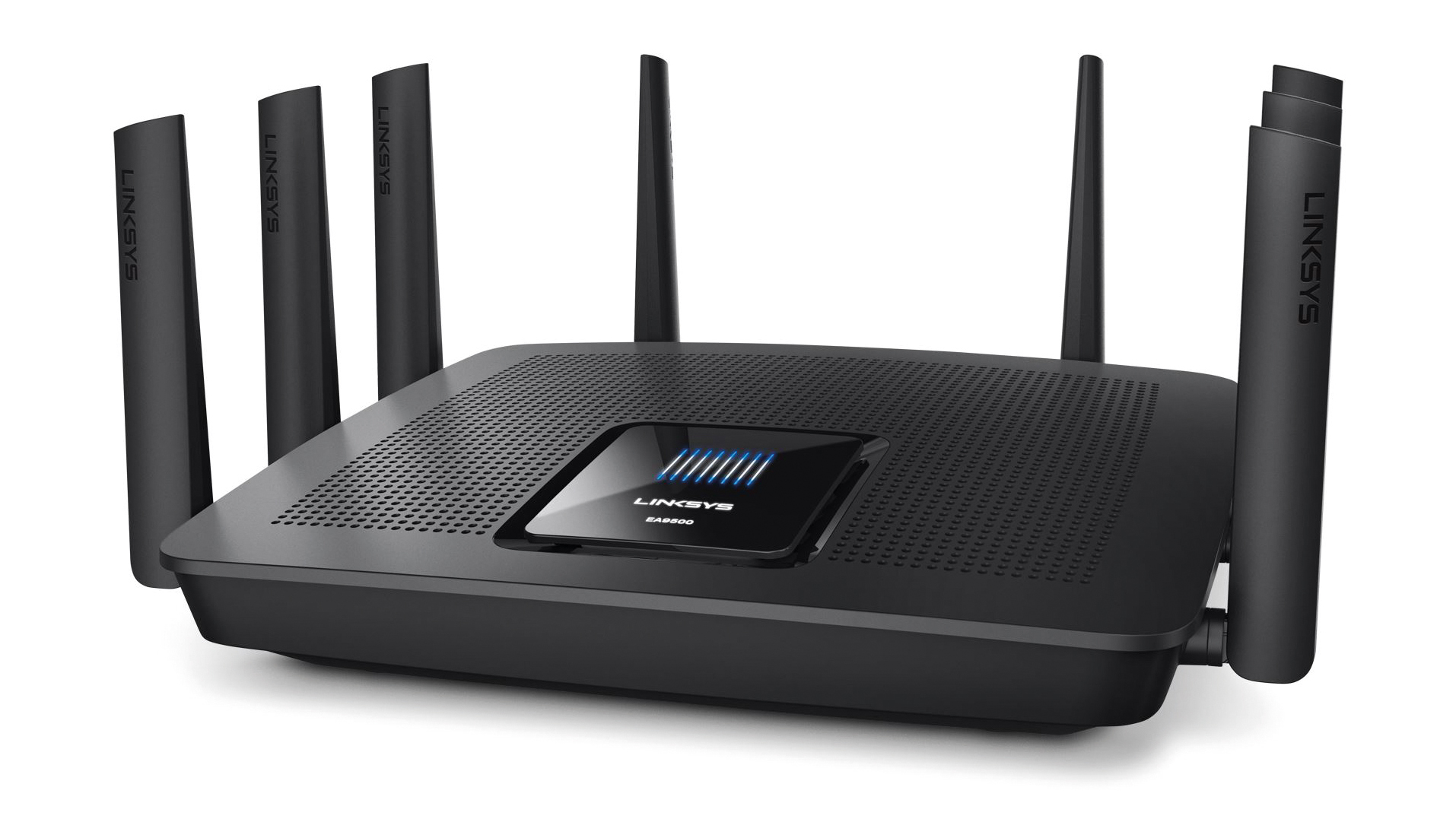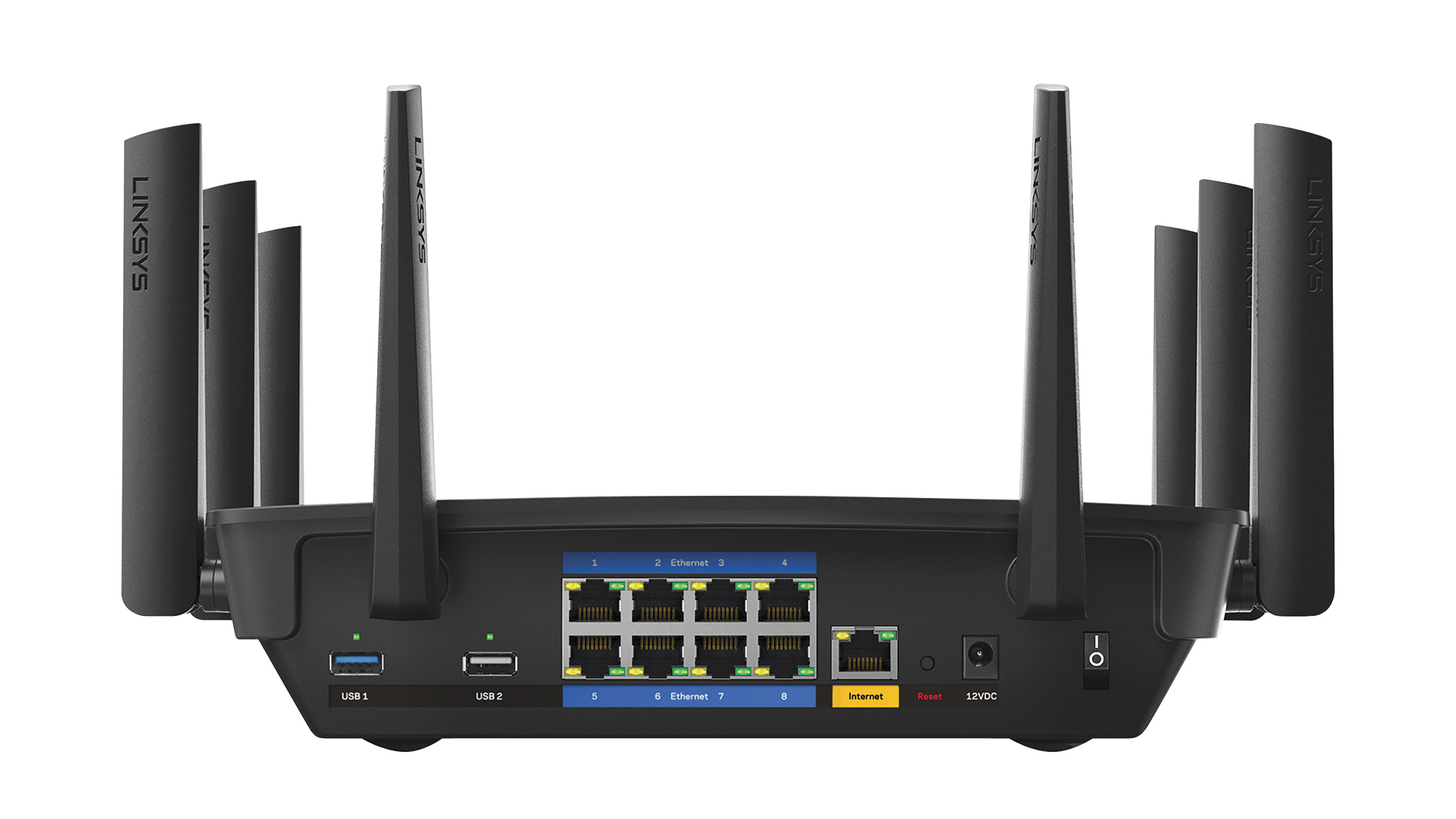Linksys EA9500 Max-Stream review: A meaty slab of a router
This mammoth piece of hardware delivers the good when it comes to performance


A heavyweight in performance as well as size, the Linksys EA9500 Max-Stream delivers everything you could need from a router, including great speed and robust features - as long as you can put up with some slightly iffy management software.
-
+
Great range and performance; Generous port selection; Alexa integration
-
-
Large footprint; unintuitive and unwieldy web console

The EA9500 is an imposing slab of a router, festooned with no fewer than eight (non-removable) antennae. It's not quite the biggest model we've seen, but it certainly fits into the plus-sized category, alongside the Netgear R9000 Nighthawk X10.
A big case with lots of aerials usually implies strong wireless performance, and on paper, the EA9500 is capable of 1,000Mbits/sec on the 2.4GHz band, and a whopping 2,167Mbits/sec on each of its two 5GHz radios. By default, these appear as a single 802.11ac network, but a band steering option works behind the scenes to balance clients across the two 5GHz connections, keeping contention to a minimum.
Needless to say, we didn't get anywhere near those speeds in our tests - but the EA9500 nevertheless served up an impressively fast connection, with solid download speeds of 14MB/sec even at the far end of our test premises. While it wasn't quite the fastest router we've tested recently, but it's easily in the top three. In short, if you're looking for fast, pervasive Wi-Fi, the EA9500 delivers.
Aficionados of wired Ethernet will be happy too. Round the back of the EA9500 you'll find a generous eight Gigabit Ethernet ports - one of the biggest allocations you'll find - in addition to a separate Ethernet WAN socket (which you'll need, as this router doesn't have a built-in modem).
There's an additional pair of USB 3 ports, allowing you to attach a printer and an external hard disk simultaneously. Be aware that the EA9500 doesn't have an internal print server, however: you'll have to install the Linksys printer software on a Mac or PC to manage and share it.
External drives meanwhile are automatically shared as soon as you plug them in, although if you dig into the web portal you can optionally set up custom shares and protect them with usernames and passwords. Interestingly, you can also make files available over the internet via FTP - a niche feature, perhaps, but a potentially handy one. Enable the DLNA server and any video files on the disk are published for streaming to compatible devices.

Most of the other features you'd hope for are present and correct - a ring-fenced guest network is created by default, and you can set up access schedules for individual devices. There's also built-in support for the dyn.com and no-ip.com dynamic DNS services, and if you connect your account to Amazon then you can ask Alexa to read out your wireless credentials, or command her to turn the guest network on and off.
There are just a few niggles, though. If you don't want to mess with your existing network settings, you can switch the EA9500 into AP mode and use it purely as a wireless access point - but there's no wireless bridge mode. Still, we doubt many people would want to use a powerful router like this as a mere extender.
More annoying is the "Smart Wi-Fi" web interface, which is nicely laid out but frustratingly slow. After every click there's a wait of a few seconds for the next page to open, which makes even the simplest administration task feel like a chore.
We're also particularly unimpressed with the network map. Linksys has taken a graphical approach here, and it's really unhelpful. Each client is represented by an icon and a name, but if you want to see an IP address, it's two clicks to open each device's information window, and another to close it again. And if you have more than 16 devices, they won't fit on a single page, so you have to flick back and forth to get a full overview. Why not just give us a conventional table?
Still, that's probably the worst criticism we can level at the Linksys EA9500 - and you can get around it by using the Linksys smartphone app, which has a cleaner interface and lets you check up on your network status and even tweak settings remotely.
All told, the Linksys EA9500 Max-Stream is a superb all-rounder. While not quite as feature-packed as Netgear's mighty Nighthawk X10, it's far more sensibly priced, delivering terrific wireless speeds and great wired connectivity. What more could you want?
Verdict
A heavyweight in performance as well as size, the Linksys EA9500 Max-Stream delivers everything you could need from a router, including great speed and robust features - as long as you can put up with some slightly iffy management software.
| Dimensions (WDH, without antennae) | 318 x 265 x 67mm |
| Wi-Fi standards supported | 802.11a/b/g/n/ac |
| Radios | 2.4GHz + 5GHz + 5GHz |
| Quoted 2.4GHz speed | 1,000Mbits/sec |
| Quoted 5GHz speed | 2,167Mbits/sec |
| MIMO channels | 4x4 |
| MU-MIMO | Y |
| Gigabit Ethernet ports | 8 |
| USB ports | 2 x USB 3 |
| Other ports | Ethernet WAN |
| WPS push-button | Soft button in web interface |
| Internal modem | None |
Get the ITPro daily newsletter
Sign up today and you will receive a free copy of our Future Focus 2025 report - the leading guidance on AI, cybersecurity and other IT challenges as per 700+ senior executives
Darien began his IT career in the 1990s as a systems engineer, later becoming an IT project manager. His formative experiences included upgrading a major multinational from token-ring networking to Ethernet, and migrating a travelling sales force from Windows 3.1 to Windows 95.
He subsequently spent some years acting as a one-man IT department for a small publishing company, before moving into journalism himself. He is now a regular contributor to IT Pro, specialising in networking and security, and serves as associate editor of PC Pro magazine with particular responsibility for business reviews and features.
You can email Darien at darien@pcpro.co.uk, or follow him on Twitter at @dariengs.
-
 ‘Phishing kits are a force multiplier': Cheap cyber crime kits can be bought on the dark web for less than $25 – and experts warn it’s lowering the barrier of entry for amateur hackers
‘Phishing kits are a force multiplier': Cheap cyber crime kits can be bought on the dark web for less than $25 – and experts warn it’s lowering the barrier of entry for amateur hackersNews Research from NordVPN shows phishing kits are now widely available on the dark web and via messaging apps like Telegram, and are often selling for less than $25.
By Emma Woollacott Published
-
 Redis unveils new tools for developers working on AI applications
Redis unveils new tools for developers working on AI applicationsNews Redis has announced new tools aimed at making it easier for AI developers to build applications and optimize large language model (LLM) outputs.
By Ross Kelly Published
-
 Google layoffs continue with "hundreds" cut from Chrome, Android, and Pixel teams
Google layoffs continue with "hundreds" cut from Chrome, Android, and Pixel teamsNews The tech giant's efficiency drive enters a third year with devices teams the latest target
By Bobby Hellard Published